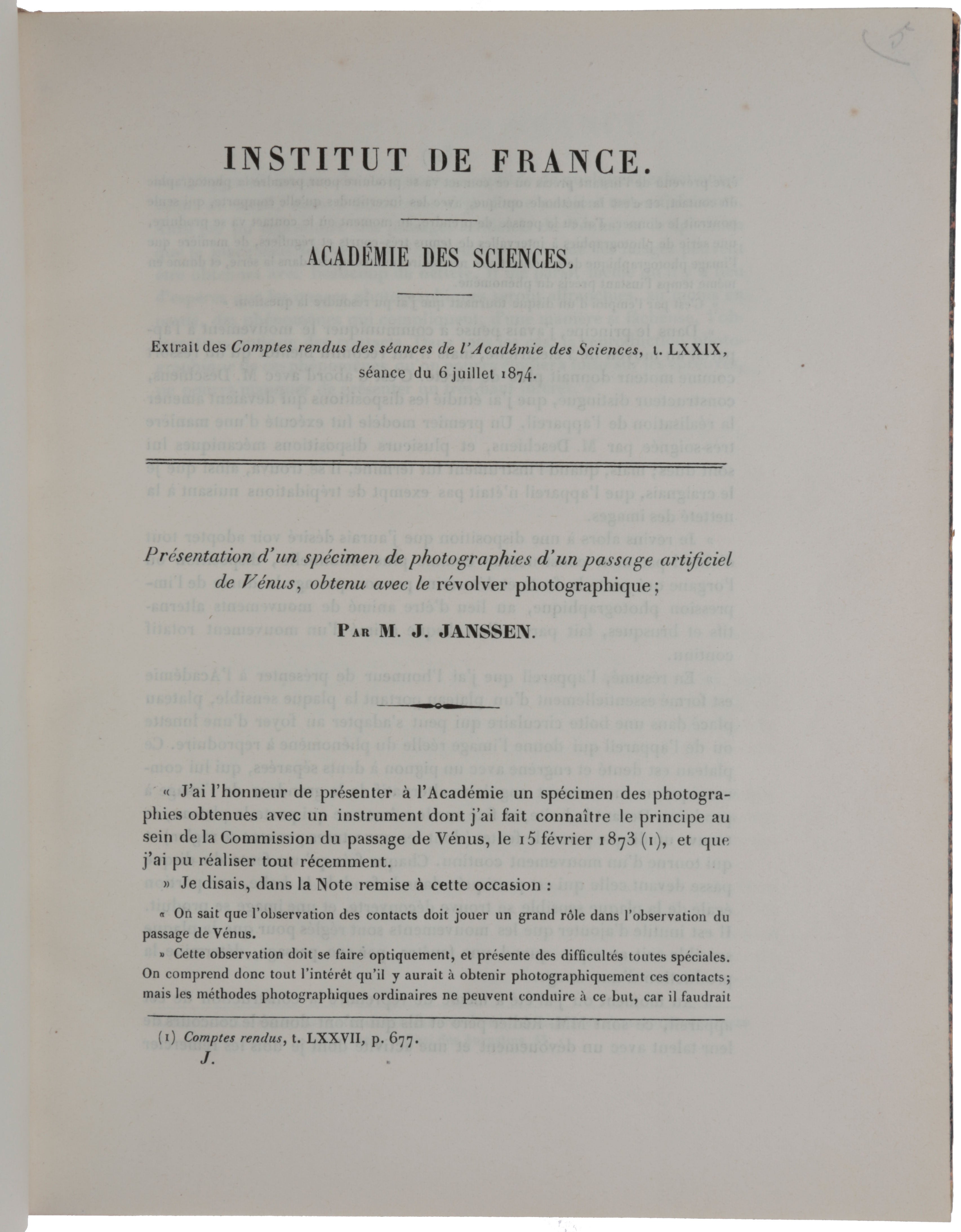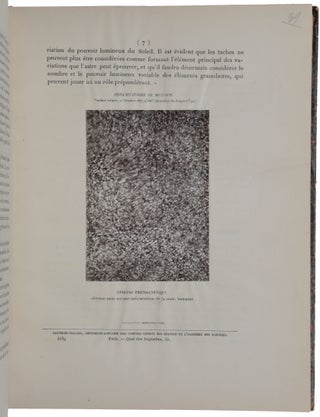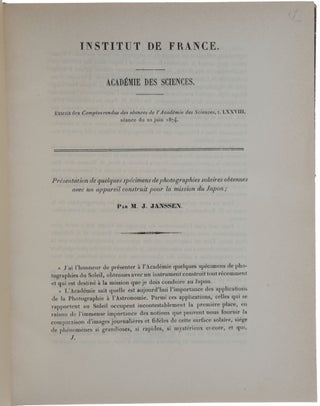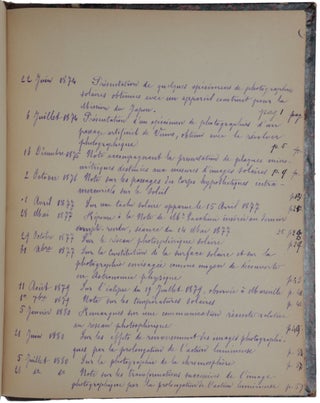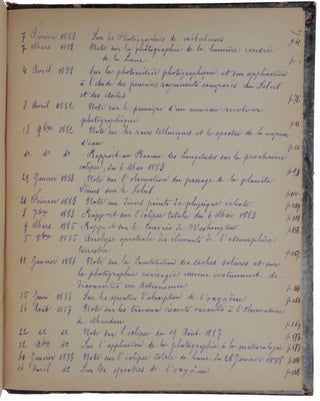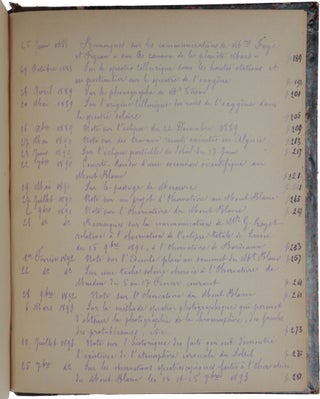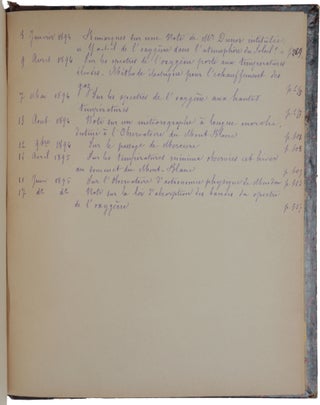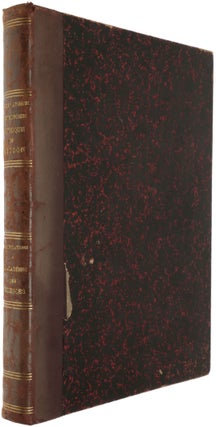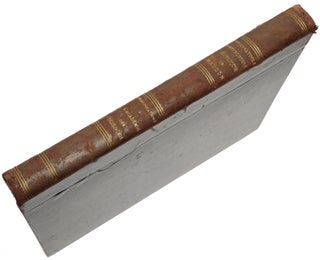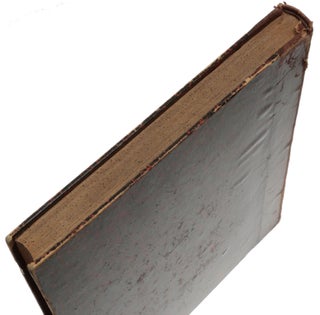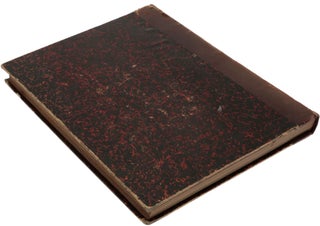Présentation d’un spécimen de photographies d’un passage artificiel de Vénus, obtenu avec le révolver photographique. Offprint from the Comptes rendus hebdomadaires des Séances de l’Académie des Sciences, Tom. 79, 6 July, 1874. Bound with 57 other offprints by Janssen from the Comptes rendus.
Paris: Gauthier-Villars, 1874-95. First edition, extremely rare offprint, of Janssen’s epoch-making description of his ‘photographic revolver’ and of its first results, “the first ‘film’” (Singer, A History of Technology V, p. 739). “The first practical device for sequential photography, invented to record the transit of Venus in 1874, was later recognized as the precursor of the movie camera … Janssen’s ‘revolver photographique’” (Launay & Hingley, p. 57). With this apparatus, the first to photograph successive phases of a single movement, Janssen “realized one of the operations necessary for cinematography” (DSB). Indeed, it was Janssen’s invention of this device which spurred Étienne Jules Marey to use it (first in March 1882) to record the flight of birds, to which Janssen responded in ‘Note sur le principe d’un nouveau révolver photographique,’ 3 April 1882 (also included here). These papers of Janssen led to Marey’s momentous experiments which resulted in the birth of cinematography, as presented by him to the Académie des Sciences on 29 October 1888. Janssen “was in the chair on this historic occasion . . . but few of the other members could have realised that these small strips of photographic paper marked the foundation of a new art and a new industry” (ibid., p. 741). “Janssen’s photographic revolver was a genuine scientific cine camera in embryo. It had a motor, an optical system, a variable shutter, and sensitive material in movement. It did not yet allow for the dynamic reproduction of movement, but it did permit its analysis … This was an anticipation of so-called time-lapse cinematography, by which … it is possible to assess movements too slow to be appreciated by the human eye” (Tosi, p. 39). Janssen constructed his photographic revolver in order to record a transit of Venus across the Sun on 8 December, 1874, as observed in Japan (in the UK, the Astronomer Royal, Sir George Bidell Airy, had all of the British transit expeditions equipped with a ‘Janssen’); these observations were important because the accuracy with which the moment of transit can be determined, as observed from different places, is directly related to the accuracy with which one can determine the distance of the Earth from the Sun. Janssen’s great paper here constitutes one of a remarkable collection of 58 offprints of his works. Many of these deal with questions in astronomy and astrophysics, including papers describing a micrometer designed to measure solar images, on the passage of hypothetical bodies between Mercury and the Sun, sunspots, solar temperature, eclipses, and the application of photography to spectral analysis. One of these, ‘Sur la constitution de la surface solaire et sur la Photographie envisagée comme moyen de découverte en Astronomie physique,’ a visionary disquisition on the potential of photography in astronomy, has an actual photograph of the solar surface pasted onto the final page, an ‘épreuve photoglyptique obtenue sans aucune intervention de la main humaine.’ A non-astronomical paper is ‘Sur le phonographe de M. Edison,’ 23 April 1889, which Janssen encountered at the meeting of the British Association for the Advancement of Science in Bath, September 1888. All of these offprints are extremely rare. OCLC records copies at the Paris Museum of Natural History or Observatory, or not at all. In the eighteenth century, several expeditions had been mounted to observe the transits of Venus of 1761 and 1769, notably those led by Captain Cook. All these efforts were in vain, because the measurements of the times of contact, i.e., the moment at which Venus begins to cross the face of the Sun, were insufficiently accurate because of the infamous “black drop” effect, which made the limb of the planet appear to be linked to that of the Sun by a dark thread, making any accurate determination of contact impossible. By the time the next transits were due to take place, on 8/9 December 1874 and 6 December 1882, photography was chosen as a means of resolving the difficult problem of accurately determining the contacts. Instead of having an observer giving a mark, an estimate of greater or lesser accuracy, at the instant of contact, and a helper recording the corresponding time, it would suffice to record the exact time that each image was exposed, and which could be examined later. Each of the French transit expeditions were equipped with a ‘photographic equatorial’, but this was not to Janssen’s satisfaction, because it gave images that were much too small. Janssen therefore had a special instrument built by means of which he was able to produce photographic images of 11 or 12cm in diameter (see [1] – numbering as in the list of contents below). “Could he not, however, do even better? Could he not, for example, design a mechanical arrangement capable of automatically recording, on the same photographic material, at each of the four contacts, a sequence of images taken at very short and regular intervals? There would then only be the need to record the time of the first exposure, and the photographic plate, the equipment’s mechanism and, after the expedition’s return, a microscope would do the rest … The idea of combining chronometry and photography had been on his inventor’s mind for some time, and on 15 February 1873, just 5 days after his election to the Académie des Sciences, Janssen presented the committee with a method, which would eventually solve the difficult problem of determining the exact times of the planet’s contacts with the solar disk by a simple, objective, and durable means. By using an annular plate, Janssen planned to record 180 images on a disk, at the rate of one per second, with the appropriate exposure time being obtained by shutter having a variable slit … “After his account of the principle of the ‘contact apparatus,’ Janssen modified his plans to have the instrument built. The disk would no longer record 180 images, but just 48, and the rotating plate would no longer be driven by electricity, but by a spring. The first form of the instrument by the maker Eugène Deschiens, although ‘carefully produced,’ did not satisfy Janssen because of vibration created by the fact that the disk with the interrupting slit did not have a constant motion … So he made the instrument makers Redier, father and son, responsible for constructing the new version of the instrument [2]. While the plate carrying the annular daguerreotype rotated by 1/48 of a turn, then remained stationary during the exposure, thanks to a Maltese-cross mechanism, the disk that carried the 12 radial interrupting slits (regularly spaced, and adjustable in width) rotated continuously at four times the rate. So when the photographic plate had finished a complete turn (in 72s), the interrupting disk had made four rotations. It was with this second version of the instrument, thenceforward baptized the ‘photographic revolver,’ that Janssen was able to carry out tests of photographs of an artificial transit, a specimen of which he displayed on 6 July 1874 that ‘proves that the images may be obtained with great clarity’ [2] … “Although the results obtained by classical photography and by the revolvers used in 1874 for the transit of Venus were hardly conclusive, Janssen had conceived and employed the first piece of cinematographic equipment which, from the outset, he intended for many other subsequent uses: recording of the successive phases of total or partial eclipses; automatic monitoring of the solar disk; the study of the motion of solar granulation [22]; the systematic examination of the circumsolar region for the transits of hypothetical intra-mercurian planets across the Sun [4]; or even the study of physiological mechanics: the locomotion, flight, and various movements of animals. From then on, the way to ‘animated photography’ was wide open to Muybridge, Edison, Marey; and the Lumière brothers! “However, Janssen remained rather jealous of his invention. He obviously knew Jules Marey very well, given that he came into contact with him both at the Académie des Sciences and at the Société Française de Photographie, and each would be President of both, but the two obviously did not associate very much with one another. When Marey announced to the Académie des Sciences, in a letter read on 13 March 1882, that he had just obtained ‘by means of instantaneous photography, a complete analysis of various forms of locomotion, including the flight of birds’, thanks to the instrument that he had finally succeeded in constructing ‘in the form of a hunting rifle’, Janssen stated during the session that he was delighted by it. Marey clearly set out the origin of his instrument and the difficulties that he had to surmount: ‘The analysis of the movement of flight demands a series of positions with the knowledge of the exact instant at which each is produced. A method that our fellow member M. Janssen devised at the time of the transit of Venus across the Sun, to follow the phases of the relative motion of these two bodies, seemed to me to fulfill, in principle, the desired conditions. But I found many difficulties in the execution of this, because of the extreme speed at which the pieces of the photographic revolver that I required, needed to move’ … “To record very rapid movements, [Janssen] suggested giving the plate a continuous motion, and said that he had already made a successful trial, finishing by photographing the solar granulation on a plate moving at 20cm per second [18]” (Launay, Ch. 8). “It was as if Janssen had invented cinematography for Venus, before even taking photographs of his beloved Sun! Was it not only 2 weeks before he presented his first trials of his revolver to the Académie des Sciences, that he declared ‘For me, it was the observation of the Transit of Venus that had attracted my attention more particularly to this field [photography], which is so fruitful and so neglected by us’ [1]. This was in June 1874, and Janssen showed his colleagues the first photographs of the Sun, recorded thanks to the special equipment that he had had made for Japan … “In 1877, he proved the importance of series [of images] by displaying photographs showing the appearance of a sunspot from one day to the next. Then he presented his discoveries concerning the solar granulation and what he called the ‘photospheric network.’ Certainly De La Rue and Rutherfurd had already taken fine images showing spots and faculae ‘but not the details of granulation, which visual instruments have revealed to our eyes’. If he, Janssen, succeeded in capturing ‘the rice grains,’ it was because he knew how to ensure he held all the technical trumps in his hand. The shapes of the grains are very varied, but are more or less spherical or spherical in origin. Their material is extremely mobile ‘particles of solid or liquid matter floating in a gaseous medium’ [8] … “In 1881, Janssen created his ‘photographic photometer,’ which enabled him to determine the sensitivity curves of emulsions and to compare ‘the photogenic intensity of plates.’ This was how he was able to state that ‘the new gelatin/silver-bromide plates that are being prepared nowadays may be as much as 20 times as sensitive as wet process collodion plates’ [17] … “[Janssen decided] not to take part in the observational campaign for the second, nineteenth-century transit of Venus. In December 1882, he simply took the opportunity of the event to carry out physical astronomy: ‘The principal aim of these observations was to study a very current question of key significance, both from the point of view of the constitution of the Solar System and that of natural philosophy: I am speaking of the composition of the atmosphere of Venus and of the presence or absence, in that atmosphere, of that aqueous element, which, on Earth, plays such a great role in all the phenomena that are related to the development of life’ [21]. “That was undoubtedly more exciting that a new attempt to determine the solar parallax, and did not require moving to a distant location where all the contacts would be observable. Nevertheless, Janssen did decide to move, to Oran, because in Algeria the Sun would be higher than in France at the time the planet entered the disk of the Sun. He would make spectroscopic observations and large photographs, where the planet would be 1cm in diameter. [However,] despite excellent observational conditions – the extraordinary ‘brilliance’ of the planet, enabling high-dispersion and high-quality spectroscopes to be used, and the extreme dryness of the site, to his great regret he had to accept the evidence: ‘I am led to admit that, when one thus eliminates the influence of the terrestrial atmosphere, the optical characteristics of water vapor in the spectrum of Venus are very weak.’ However, he still tried to retain a glimmer of hope: ‘This does not mean, to my mind, that this element is absent in Venus’ [21]” (ibid., Ch. 9). One question which Janssen attempted to answer in his later years was whether the Sun contains oxygen or not. An indispensable preliminary was the virtual elimination of oxygen-absorption in the Earth's atmosphere, and his bold project of establishing an observatory on the top of Mont Blanc was prompted by a perception of the advantages to be gained by reducing the thickness of air through which observations have to be made [40, 42, 43, 45, 47, 50]. This observatory, the foundations of which were fixed in the hard ice that appeared to cover the summit to a depth of over ten metres, was built in September 1893, and Janssen, in spite of his sixty-nine years, made the ascent and spent four days taking observations. “Pierre Jules César Janssen was born in Paris on 22 February 1824. An accident at a young age left him unable to walk, which prevented him from attending school. He began working as a bank clerk at age 16, and began studying mathematics in his spare time. He eventually entered the Sorbonne, graduating in 1852 with degrees in mathematics and physical sciences, and obtaining his doctorate in 1860. Remaining at the Paris university, he first worked at the faculty of medicine on the design of medical instruments, then became professor of Physics at the school of architecture. He was elected to the Académie des Sciences in 1868, and in 1876 took the helm of the newly founded Observatoirede Meudon (near Paris), a position he held until his death in Paris on 23 December 1907. “In 1862, impressed and fascinated by the spectroscopic work of Gustav Kirchhoff and Robert Bunsen, Janssen began his studies of the solar spectrum. His first important contribution was to demonstrate that some of the dark lines observed in the solar spectrum were caused by water vapor in the Earth's atmosphere. He made lasting contributions in solar spectroscopy, in particular in the observation of solar prominences. Following his observations of the 1868 solar eclipse in India, he suggested that some of the unknown spectral lines observed above the solar limb were due to a hitherto unknown chemical element. Norman Lockyer independently and simultaneously arrived at the same conclusion, and both men are now credited with the discovery of Helium. “Janssen never let his infirmity get in his way. He traveled to the summits of the Mont Blanc in the French Alps, and to the Faulhorn in the Bernese Oberland, to carry out spectroscopic observations above the bulk of the Earth's atmosphere. He also made extensive use of hot air balloons for the same purpose, including a particularly daring flight to escape the 1870 siege of Paris during the Franco-Prussian war, and to observe a solar eclipse on December 22 at Oran, Algeria (which he finally could not observe because of bad weather!). “Janssen was also an early pioneer in the use of photography in solar physics. His extensive series of photographs of the solar surface were published in 1904 in his Atlas de Photographies Solaires. This work established the standards of solar photography, and the quality of Janssen's solar photographs was to remain unsurpassed for nearly half a century” (Biographical Encyclopedia of Astronomers). Launay, The Astronomer Jules Janssen, 2008. Launay & Hingley, ‘Jules Janssen's ‘Revolver photographique’ and its British derivative, ‘The Janssen slide’,’ Journal for the History of Astronomy 36 (2005), pp. 57-79. Tosi, Cinema before Cinema, 2005. CONTENTS:
58 offprints in one vol., 4to (262 x 207 mm), various paginations, from Comptes Rendus des Séances de l’Académie des Sciences, with a mimeographed list of contents bound in at the end. Contemporary calf-backed marbled boards.
Item #5495
Price: $12,500.00

